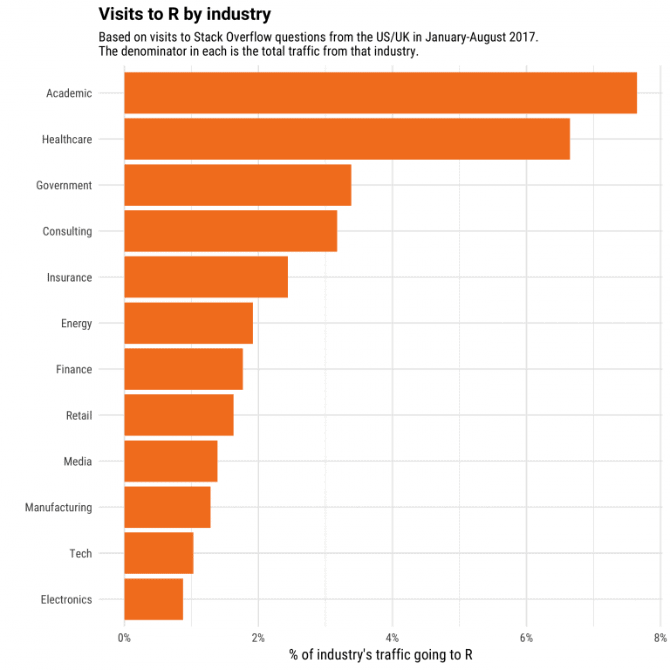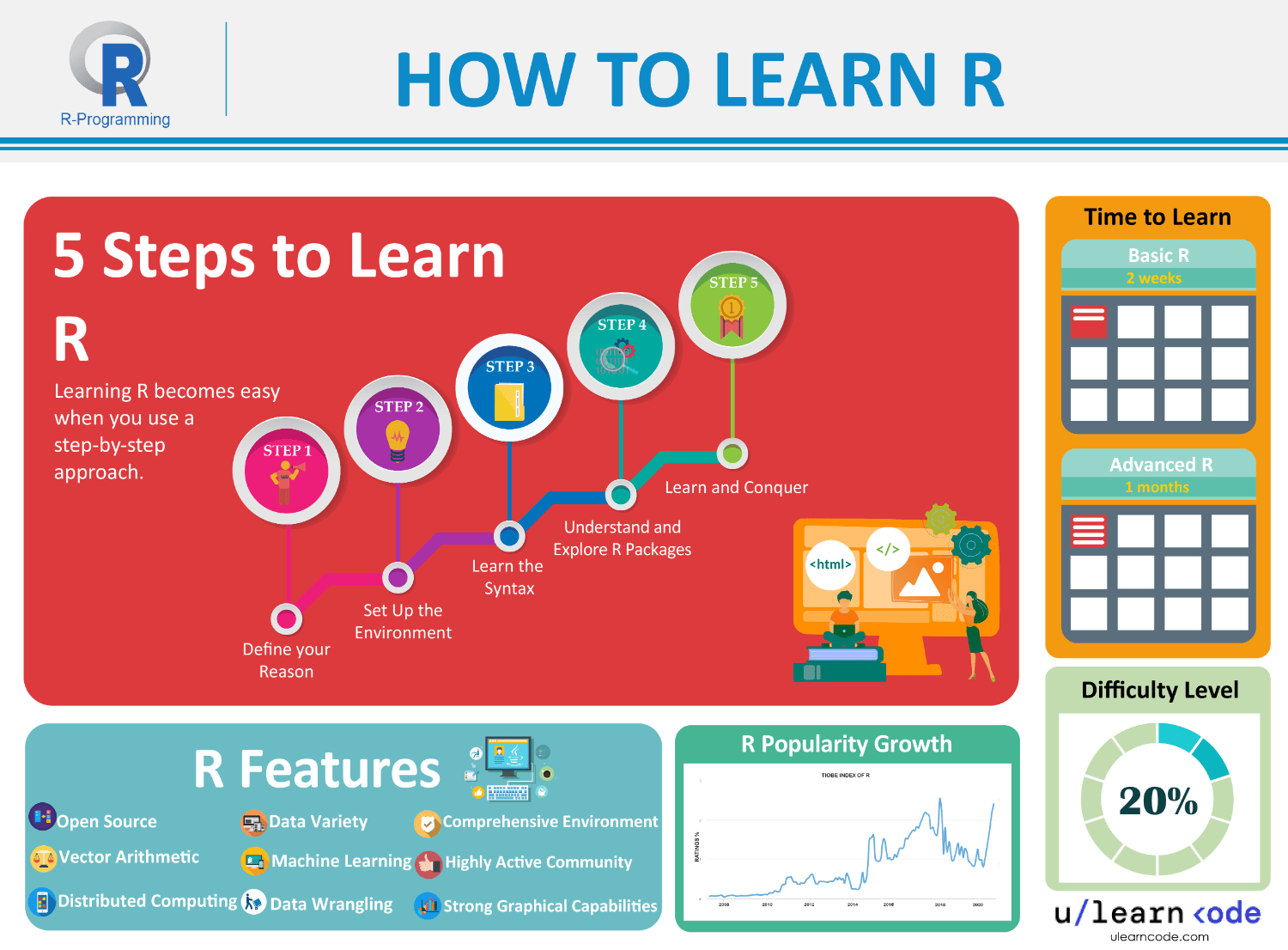Contents
R is the language of choice for a variety of industry professionals including:
- data miners
- mathematicians
- statisticians
The language is mainly used for statistics and data analyses. The Project R Core Team developed this language back in 1993 and then made it into an open-source resource for programmers.
Data Science is a key domain in which R language is widely implemented by working professionals. The statistical operations can engage with both structured and unstructured data types.
Data-driven insights and information can be extracted using R to effectively develop new consumer products and services.

R is the optimal choice if you are looking for an environment where data can be:
- analyzed
- processed
- transformed
- visualized
R has a number of applications in not only Data Science and visualization but also within the domain of Machine Learning. This makes it a great option for anyone who is eager to work in the fields of data science and analysis.
Is R Language Easy to Learn?
The R language deals with traditionally complex fields such as Data Sciences and Machine Learning. These domains typically require a certain level of knowledge and expertise. It can be common for those learning R to find it difficult to deal with these intricate subjects initially.
R is designed for use by statisticians, mathematicians and data scientists and these professionals usually find it easy to learn this language as they already have a strong knowledge base. It is also important to have a strong mathematics background in order to competently deal with R and its applications.
However, R is not entirely impossible as its syntax can be understood by beginner programmers, but further complexity issues may occur later when programmers are required to handle real data and stats.
The language itself might not be independently sufficient in developing something special and you need to have knowledge in statistical math or other data science subjects to use the language to its full capability.
R language is learnable for every person, but difficulty levels are dependent on your pre-existing core math, statistics, and other analytical skills.
How Long Does It Take to Learn R?
It commonly takes 3-4 weeks for a beginner programmer to learn the basic underlying concepts of R language. However, experienced programmers can potentially learn the core R concepts in less than a week if they consistently dedicate 3 hours daily to learning R.
There is no definite and final time estimation for any person who is willing to learn R. If you are from a strong mathematics, analytics, and statistics background then you will find R enjoyable and accessible which is why it is the industry standard for statisticians and mathematicians.
Moreover, the language includes a large number of user-created packages which can be utilized for various purposes. The implementation of these packages is a further skill that you will have to master during your learning process.
These packages will enhance your statistical techniques and give you further tools which you can utilize for your own independent projects.
5 Steps to Learn R

When learning any new programming language, it is important to have your learning path established.
R beginners can struggle with the multiple pathways available and they sometimes find it difficult to grasp the basic concepts of the language and that is why these five steps are important to follow for a smooth learning experience.
Step 1: Define Your Reason
R has limited applications which are focused on a number of domains such as:
- Data Sciences
- Machine Learning
- Data Analysis
- Data Visualization
Professionals from different analytical backgrounds such as data scientists and statisticians prefer to learn this language as they can implement it consistently. Similarly, you must also define the goals that align with your current position.
If you want to become a modern programmer who develops web applications and software, then R is probably not the right choice. However, R is going to be highly beneficial if you want to contribute to research in the sectors of:
- genomic analysis
- finance
- real estate
- paid advertising
The language has its applications in academia as well and students often learn R to deal with statistical computing and graphics. So, identify and consider your underlying reason for learning R before you proceed with the next step.
Step 2: Set Up the Environment
Every programming language needs a specific coding environment in which developers can learn and write codes to solve certain problems. First you must install R on your computer to get started. You can download this Comprehensive R Archive Network Package to run R on your local machine.
The package is available for Linux, Mac and Windows platforms and it is also completely free to install. After installing CRAN, you will have your console to execute statements, but an IDE is also important to develop, test and create complete programs, here are two preferable IDE options for R:
Step 3: Learn the Syntax
R syntax can be complex for new learners and you may have to pay especially close attention in order to grasp most of the concepts.
The most reliable option in this case is to choose the one of the best R courses created by R experts, allowing you to learn the basis. However, there are several other sources available as well, such as those listed below.
- freeCodeCamp.org – Learn the Basics of Statistical Programming
- Data Camp – R Tutorials for Data Sciences
- David Langer – Introduction to Data Science with R
These free to watch playlists and videos discuss basic R ideas along with their relation to Data Sciences. Harvard also offers R courses, most of which are entirely free.
Step 4: Understand & Explore R Packages
R has an abundance of user-created packages, it is estimated that there are over 10,000 packages available and all of them are used for specific purposes. The comprehensive list of available CRAN packages is available on their official website. These packages are easy to install and can be implemented immediately.
Step 5: Learn & Conquer
The R language has a diverse range of uses. You cannot just hop into each of its applications and that is why you must master specific domains within your core interest.
Once you have a good grip on syntax then you can decide whether you want to pursue your career as a data scientist, statistician or a machine learning engineer.
Explore the relevant R packages that will facilitate your learning journey and master your chosen domain by taking specific courses as offered by industry experts. You should also explore and join R Communities to get in touch with R experts who can help you achieve your learning goals.
To Sum Up
R might not be as popular as Python or Java, but it is a potentially crucial language if you are looking to work in data sciences and other relevant fields where demand for R developers is very high.
Do not learn this language just for the sake of financial gain, as it is complex, and you may be at risk of burning out. However, if you are passionate about data analytics, statistics, and data visualization this may well be the language for you.